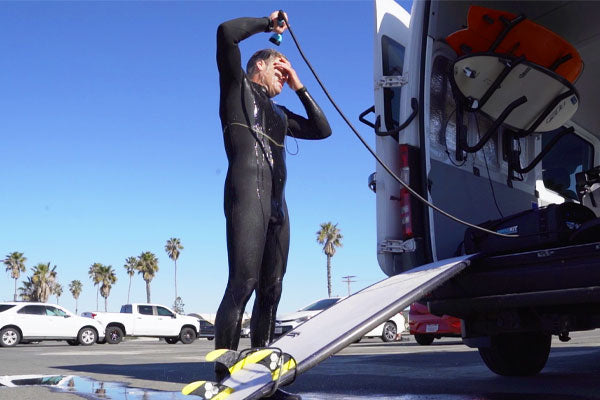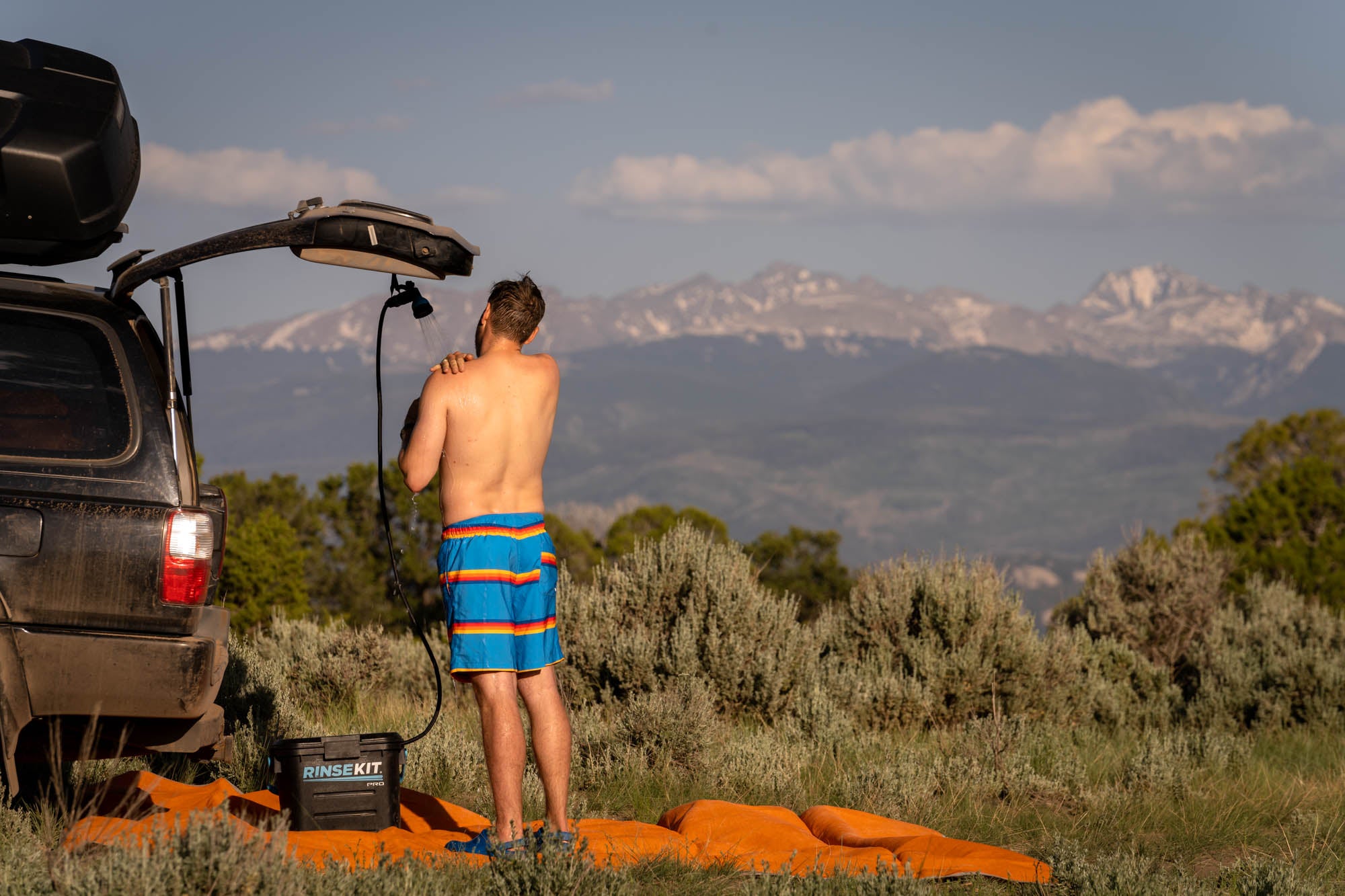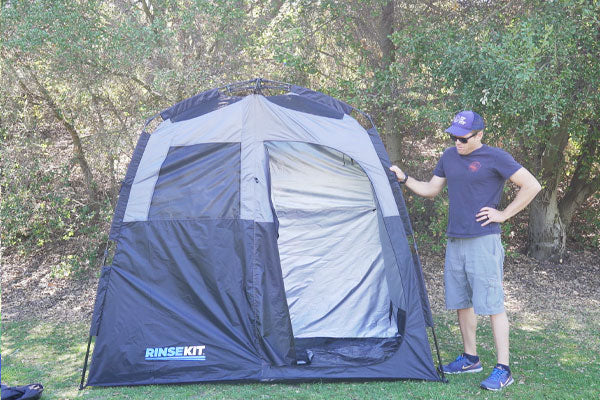Winter is coming, and for many surfers, the cooling water and air temps bring mixed emotions. On one hand, there is the benefit of thinning crowds and large winter swells. On the other, there is the sting of the cold water, and depending on where you live, frigid temperatures that can push even the toughest surfers to their shivering limit. Wherever you live, say besides maybe Florida or south of the border, you likely struggle to keep warm before, during and after your surf session in the winter.
At RinseKit, our staff is made up of surfers from both the east and west coast - so we are familiar with varying degrees of cold water surfing. However, whatever coast you’re from, there are certain measures you can take to make your cold water surfing experience less painful, and maybe, even pleasurable. So in the interest of helping all our fellow cold water warriors stay warm this winter, we compiled a list of our top 10 tips for staying warm when surfing in the winter.

Let’s start with what you can do before you go surfing.
1. Make sure your wetsuit is stored in a warm, dry place.
This tenant is an obvious one to surfing veterans, but its importance cannot be understated. There is no worse way to start a coldwater surfing session than to step into an already wet and cold wetsuit before you get in the water. The goal when surfing in cold water is to retain as much heat as possible for as long as possible, and if you’re stepping into a cold wetsuit in the parking lot, you are setting yourself to be cold in the water shortly after.
When you get home from surfing, a good place to hang your wetsuit to dry in the winter is from your shower head with a clothes hanger, particularly a thick sturdy one if you have it. If you store it outside, even under shelter, it could get wet and will definitely get cold. Hanging it in the shower, as long as it doesn’t get more wet, allows you to store it in a climate controlled environment, so that it's nice and warm when you grab it for your next session.
2. Eat or drink something hot on the way to the beach.
You want to be as warm as possible before you step out of our heated car and into the brutal cold - so warming up your insides can be a good strategy for retaining heat. Hot coffee, tea, or even soup in your car can help elevate your body temperature before you step into the cold. Holding onto the hot cup or bowl can also keep your hands warm as long as possible - which helps as your fingers are typically the first thing to go numb when it's a cold day.
In order to maintain a normal body temperature, your body also burns more calories when it's cold. That’s why having a legit meal in your stomach before the session is important - as you need those calories to keep your engine hot.
3. Blast your heat in the car.
This is another obvious, but understated form of cold preparation. As your extremities are the first thing to go when the water is frigid, it’s important to keep your feet and hands as warm as possible before you get in the cold. That means you need to blast your toes and your hands with heat for as long as you can on the way to the beach, so they are nice and toasty when you get out of the car.

4. Pour hot water into your booties.
This method is a little less orthodox, and can be effective, especially on the coldest days. If it’s cold enough where you have to wear booties, you can slightly prolong your warmth retention by pouring hot water into your booties before you paddle out. This will at least keep your feet toasty until the first real water flush, which, if you’re careful, may not happen until you get out to the lineup after your first paddle. Since surfing requires you to feel your feet, well, this may prolong your session and your performance another 15 minutes.

5. Wear more rubber.
It’s obvious, but wearing a thicker wetsuit will always keep you warmer. If you want to extend your winter sessions, or if you find yourself getting uncomfortably cold quicker than you’d like, the solution is always to get a thicker wetsuit. That goes for booties, and gloves as well. Depending on your tolerance, you can typically follow these guidelines for what thickness of wetsuit you should wear based the range the temperatures lies within:
68° - 55° 3/2
55° - 43° 4/3
43° and below: 5/4
So those are some measures you can take before you get in the water to make your overall cold water surfing experience better. Now, let’s take a look at a few tips for what you can do while you’re in the water, to maintain your body temperature for as long as possible.
6. Keep moving.
When you’re out in the lineup, the worst thing you can do for retaining your body temperature is to keep still. To keep your blood pumping and your body temperature up, you need to keep paddling, even when there’s no waves. You may tire quicker, but ultimately your session will last much longer if you keep moving throughout the session.

7. Wear a hood.
As uncomfortable as they may be, wearing a hood can greatly extend your time in the cold water. You can lose a lot of warmth through the top of your head, and your ears can get numb pretty quickly if it’s cold enough. Wearing a hood will hold all that heat in, and keep your ears nice and toasty.
8. Make sure your boots and gloves stay tucked in.
One way to ensure your cold water session will be cut short is to let your boots and gloves become untucked. When they are tucked into your wetsuit, they don’t let water in, keeping your system of rubber sealed and warm. When your boots and gloves come untucked though, not only will they take on water, you will take on water in the main part of your wetsuit. This is the quickest way to end your session, as your hands, your feet, and your body will get too cold to surf - in that order.
So those are some measures you can take while you’re out in the water to prolong your session. Now let’s look at what you can do once you get out, so you can warm up faster and get the feeling in your fingers back quicker.
9. Start your car and turn the heat up full blast while you’re changing.
Soon as you get back to your car, you should turn on your car and turn the heat on full blast. That way, while you’re changing out of your suit, your car will be heating up and your heat will be getting hot. When you’re done changing and you hop in your car, it will be nice and toasty, and you’ll be able to heat your feet and hands back up quickly.
10. Bring a heated portable shower in your vehicle.
There’s no better way to heat up after a cold surf than a hot shower. If you’ve surfed through a cold winter, you know this. But typically, that hot shower is a car ride home, so you have to suffer through the cold until then. That is of course, unless you have a heated portable shower in your vehicle.
Types of Heated Portable Showers
If you’re unfamiliar with what a portable shower is, it’s what it sounds like - a shower you can take in your vehicle. While there are all types of portable showers, if you’re cold water surfing, you’ll want one that is capable of heating up water - which really limits your options.
So if you do your research for portable hot showers, you’ll find that you have a few options.
If you’re cheap, you can of course fill a solar shower bag with hot water before your session, or hope that if you leave it in the Sun it will heat up. Most likely, if it’s cold outside, it won’t heat up in the Sun, and even if you fill it up with hot water, it will likely be lukewarm at best after sitting in your cold car for the duration of your session.
The same goes for hand-pump portable showers. You can always fill it with hot water before your session, hoping it will stay warm long enough to be somewhat hot at the end of your session. But, since there is no insulation around most of these hand pump showers, it will most likely lose most of its heat within an hour or so - definitely not enough to significantly warm you up after a session.
There are propane heated portable showers, and they are probably the best option heat-wise. They use small propane tanks to heat water that is pumped through the heater via an external source, like a bucket of water. These can be a good option, but the issue is that most of them are complicated to use, have bad water pressure, and as we said, rely on an external water source. There’s a lot of moving parts there that you may not want to mess with your hand are literally numb - and they’re not going to give you the pressure you expect out of a nice hot shower at home.
The RinseKit PRO + HyperHeater Combination

At RinseKit, we invented the first portable shower. Founder Chris Crawford invented the original RinseKit for showering after surfing when he had to go back to work at his pool cleaning job. Since Chris is also a cold water surfer, he’s been obsessed with heating the water inside the RinseKit- so even the early models had heating options.
Over the years, Chris has perfected the function of RinseKit as a portable shower - by going from a self-pressurization method to battery pressurization for creating water pressure. The point of the RinseKit was always to be an all-in-one kit that had everything you would need for a portable shower, and he stayed true to that path in the development of the RinseKit PRO, the first battery-pressurized model. Now, to use the RinseKit you just pour water into the tank and press the power button, and you get 50 PSI of pressure without pumping or pulling from an external water source.
Seeing that propane was the most effective way to heat water, Chris eventually developed the RinseKit HyperHeater to pair with the RinseKit PRO. The HyperHeater is a propane water heater that, when paired with the PRO, pumps water out of the PRO, cycles it through its system and heats the water up to 110 F in around 30 seconds. The water comes out of a powerful shower head steaming hot in no time.

The HyperHeater and the PRO together create a fully self-contained portable hot shower system that allows you to have hot water instantly anywhere. So if you’re getting out of the water after a frigid session, there is literally no more efficient and easy way to take a hot shower at your vehicle. It will warm your hands, feet and body back up in no time, and you’ll be comfortable much quicker. Oh, and everyone in the parking lot will be very envious.
So if you’re a cold water surfer and you’re looking for ways to stay warmer before, during, and after your sessions this winter, we hope you find these 10 tips helpful. Taking these measures will allow you to surf longer, better, and warm up quicker when you’re done. Depending on where you live, these could be life-changers, especially if you need to warm up quickly after a session.



